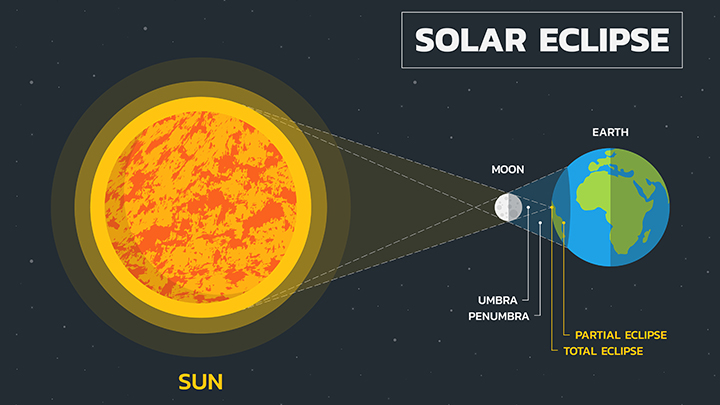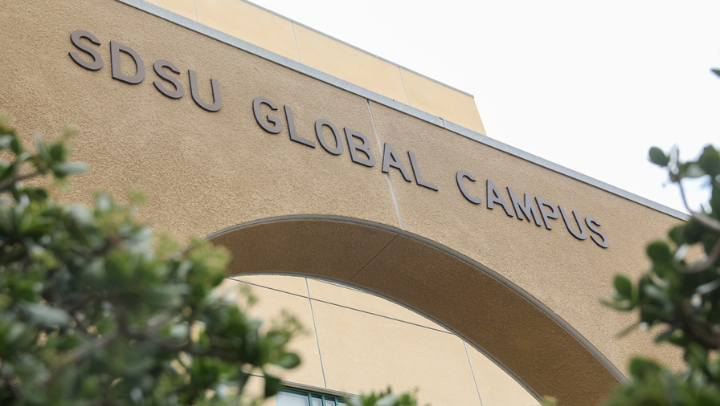Q&A: Watching the April 8 solar eclipse in San Diego
Even though San Diego lies outside of the path of totality, SDSU astronomer Douglas Leonard says we will still get to see the celestial phenomenon.

The upcoming total solar eclipse will wow observers from Mazatlán to Maine on the morning of April 8, but here in San Diego, the moon will take just a bite out of the sun. Still, the opportunity to view this celestial phenomenon doesn’t come around often.
NewsCenter’s Susanne Clara Bard spoke with SDSU associate professor of astronomy Douglas Leonard about what to expect during the eclipse and how to protect your eyes if you look up at the sky that day.
What causes solar eclipses and what are the different types?
There are three types of solar eclipses: Total, annular, and partial. All are caused by the moon — as it is orbiting around the Earth — temporarily moving into a position where it blocks the Sun from our view. In a total solar eclipse, the moon completely blocks the disk of the sun, and in a partial eclipse, the moon only covers part of the sun. An annular eclipse occurs when the moon is in the right position to produce a total solar eclipse, but its angular size in our sky is a bit too small to completely cover the sun. This occurs since the moon orbits the Earth in an ellipse, and sometimes it is caught near its furthest point from Earth at the time of the eclipse.
What does a total solar eclipse look like?
The “path of totality” is a thin strip (about 100 miles wide) along the globe, within which a total solar eclipse is visible. On April 8, the path of totality begins in western Mexico and then streaks across the central and eastern United States before exiting through southeastern Canada.
During totality, you’ll not only get to see the tenuous outer atmosphere of the sun (its corona), but other stars as well since it will temporarily become dark enough. With a telescope, more exotic phenomena are visible, including something known as Baily’s Beads — an effect that happens right before and right after totality where the sun’s light travels through craters on the lunar surface to produce little “beads” of light just beyond the lunar silhouette.
Since San Diego is outside the path of the path of totality on April 8, will viewing still be worth it?
If you’re not in the path of totality, but are reasonably close to it, such as in San Diego, you’ll get a partial eclipse. While total eclipses are way more impressive, partial eclipses are still definitely worth viewing if done so safely. You should never attempt to look directly at a partial solar eclipse. Instead, only look at it through special eclipse glasses or telescopes equipped with solar filters.
Here in San Diego the partial eclipse begins at about 10:03 a.m., when the moon’s disk just begins to cross the sun; maximum eclipse occurs at 11:11 a.m., when roughly 54% of the sun’s disk is occulted; and by 12:23 p.m. it’s all over! Unless you’re aware it’s going on, you probably wouldn’t even notice it’s happening — it won’t become appreciably darker or cooler.
If you want to prove to yourself that it's happening, simply take a pin and poke a small hole in an index card and let the sun’s image shine through it onto a sheet of paper held behind it — you’ll see the crescent image of the sun!
What is the safest way to watch the eclipse?
If you do not have specially equipped glasses, do not attempt to look directly at the partially eclipsed sun, ever. To look directly at the sun — either with your own eyes directly or with a telescope — you need to be employing very special filters that block out more than 99% of the sun’s light. You can either buy these special glasses or you can purchase a piece of arc welder’s glass of shade #13 or #14. Only with this proper protection should you ever view the sun directly, even when it is partially eclipsed.
Note that it is always dangerous to view any part of the sun’s surface directly without proper filters, any day of the year, not just during an eclipse. If you do happen to look directly at the sun – even for just a few seconds – you can risk permanent eye damage, including a nasty condition called solar retinopathy, which causes injury to your central retina. Bottom line: Be very careful to only ever view the sun through approved filters.
If you wish to (safely!) view the eclipse while on campus, the astronomy department – in tandem with the Schwartz Astronomical Society, our astronomy club – will have telescopes and solar sunglasses to look through during the eclipse in the Mediterranean Garden, which is located just west of the Physics/Astronomy building.
When will the next total solar eclipse be visible in San Diego?
Total solar eclipses can occur a maximum of two times per calendar year. Unfortunately, no total eclipses will be visible from San Diego in the next century. And the next one that will cross a significant swath of North America is over 20 years away – on August 12, 2045. That one has a path of totality that crosses into Northern California and then exits through South Florida, and about 80% of the eclipse will be visible from San Diego.




